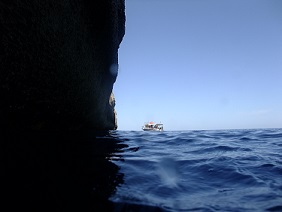Forna Point
Forna Point – Gozo
06.05.2012
Forna Point (Ras il-Forna) is the first headland beyond Wied il-Ghasri on the North facing coast of Gozo. From here onwards until it runs out of land at Cape San Dimitri (Kap San Dimitri), the North facing coast line becomes a bastion of sheer cliffs, the base of which is riddled with sea caves.
So this was the scenario which we knew was awaiting us at Forna Point as we boarded the Atlantis II anticipating this dive. Weather conditions were excellent, with just the lightest of SE ruffling the surface. With this dive site, and these conditions, more divers were persuaded to join the boat dive.

Once Forna Point is rounded, there is a cave with a huge entrance – l-Ghar tal-Margun, translates into Cormorant Cave – and the dive plan was to initially, have a look inside this cave, then follow the cliff face which becomes a sheer wall, heading West (keeping the wall on the left), and explore any other caves which might be encountered along the way. Since there is nowhere that the Atlantis could anchor, this was to be, as might be guessed, a drift dive.
Margun Cave bottoms out at about 24m, but we could see that we were on a sort of ledge at a lower level than the proper cave floor – we could have gone up that ledge to enter the cave proper, but it was evident that if we did so, we would have spent a considerable amount of time at a depth of about 15m, which would have meant that we would have to spend the remainder of the dive at a low depth. This time we opted to explore this ledge, and then once out of the cave we descended to a maximum depth of 32m, after which we started a gradual ascent along the wall.
We maintained a relaxed pace, explore the cliff wall, which is literally covered with sponges, spiral worms, calcareous growths and orange hydroid colonies on the undersides of ledges and boulders. We were really enjoying ourselves – and the slow pace enabled us to really stretch the dive – then in the 60th minute we came to a cave entrance. The cave had a recess on the left hand side, into which we went. This part of the cave goes in for about 20m I would estimate. Since the entrance is facing north, and not much light penetrates, so the inner walls are quite bare, but the outer ones are simply covered with orange hydroids and multi coloured sponges. The presence of fresh water was detected. Here I had a look at my pressure gauge, and it was now just inside the red zone, so I kept at about 6m.

Sea life: just as soon as we entered the previously mentioned Margun Cave, we came across a bright orange nudibranch about 35mm in length – it was later identified as berthella aurantiaca. Further on along the wall we came upon a ‘cow’ nudibranch (Discodoris Atromaculata), and then in the second cave, we saw a forkbeard (lipp), and a large conger eel (gringu).
And to top it all, we got good value for money, since we managed a 72 minute dive!


